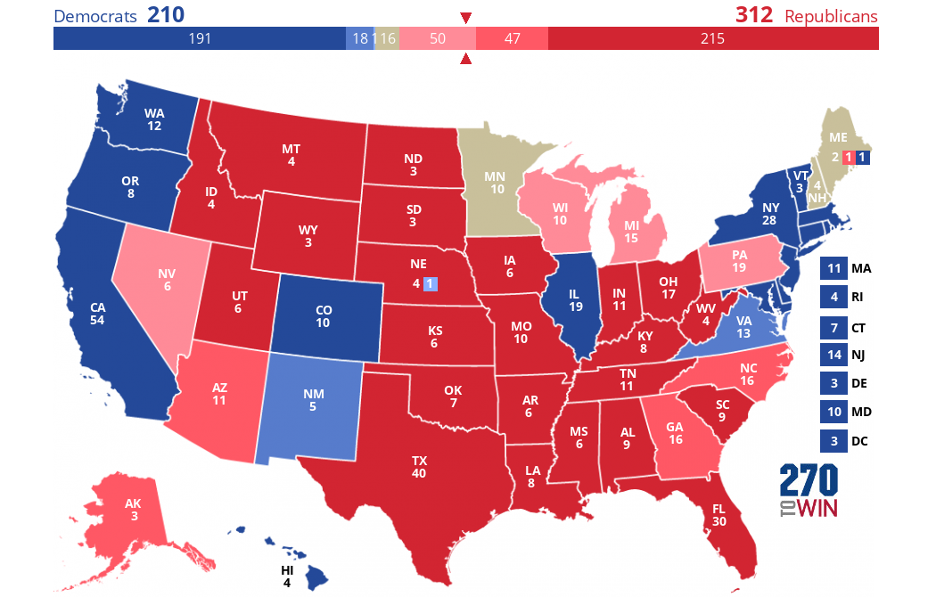As the 2024 presidential election approaches, it is my prediction that the electoral landscape is shaping up favorably for Donald Trump. Through an in-depth analysis of voter turnout trends, demographic margins, and shifting political dynamics across the states, I believe the data shows a strong path for Trump to secure victory, particularly in the Electoral College.
Historically, voter turnout in the United States has averaged around 60%. However, the 2018 midterms and the 2020 presidential election saw spikes in voter participation, with turnout reaching as high as 67%. In 2024, I predict a return to pre-2020 levels, with turnout around 61%. The enthusiasm that once fueled Democratic victories—particularly among minorities, millennials, and Generation Z voters—appears to have waned. Disillusionment, lower voter registration rates, and reduced interest among these groups are likely to lead to decreased participation, which could significantly impact the Democratic nominee’s total vote count.
Swing State Analysis
- Arizona: Trump +6
Arizona is expected to swing back to Trump. The Mexican American vote in the state continues to trend in his favor, reflecting similar patterns in other parts of the Southwest. Additionally, the youthful growth and suburban turnout in Phoenix, which significantly boosted Democratic margins in 2020, are not expected to replicate in 2024. The Mormon vote, previously split, is also returning to Trump, strengthening his position.
- Georgia: Trump +5
Georgia, which narrowly went blue in 2020, is likely to revert to its traditional Republican leanings. The state’s liberal mail-in voting rules maximized Democratic turnout in 2020, but such conditions will not be repeated. Additionally, there is no cultural or electoral phenomenon similar to that of 2020 to boost Democratic enthusiasm. The data indicates that lower Democratic turnout, combined with stronger Republican support in rural and suburban areas, will give Trump a comfortable victory.
- Michigan: Trump +3
Michigan is trending in Trump’s favor, with a predicted margin of +3. The state’s rural and suburban voters, particularly those with Appalachian roots, show signs of returning to Trump’s 2016 levels. Meanwhile, Harris is struggling to maintain the Democratic coalition that Biden held together, especially with Arab-American voters and working-class communities. Reduced enthusiasm and turnout in these groups are likely to tip the state to Trump.
- Nevada: Trump +3 to +4
The Mexican American vote in Nevada, which did not shift as significantly towards Trump in 2020 as in other states, is now trending Republican. This trend, combined with lower urban and suburban turnout in traditionally Democratic areas, makes Nevada likely to go to Trump.
- North Carolina: Trump +6
North Carolina is firmly in Trump’s column. Voter registration and early voting data suggest that Democratic enthusiasm is far below what is necessary for competitiveness. The state’s rural areas, coastal regions, and key suburban areas lean heavily Republican, reinforcing Trump’s hold.
- Pennsylvania: Trump +4
Pennsylvania, a key battleground, is expected to swing back to Trump with a +4 margin. The state’s demographic dynamics—particularly in rural counties and the Scranton area—show a trend back to Trump’s 2016 levels. While Harris may hold onto the margins Biden achieved in the Philadelphia suburbs, she is likely to underperform in other key areas such as Philadelphia proper and Lancaster due to decreased Black turnout and reduced overall enthusiasm.
- Wisconsin: Trump +4
Wisconsin shows a similar trend to other Rust Belt states. Trump is projected to win by +4. The critical areas of Madison and suburban regions around Milwaukee are displaying declining enthusiasm for the Democratic nominee. Meanwhile, rural areas and counties with Northern European ancestries, which favor Trump, are seeing increased turnout.
Analysis of Additional States
- Florida: Trump +11
Florida is solidly red, with Trump projected to win by a significant margin. Shifts among Cuban, Venezuelan, and Colombian voters in South Florida, alongside gains among Puerto Rican and Hispanic voters in central Florida, strengthen Trump’s position. This shift in Hispanic support makes Florida no longer a swing state but a strong Republican hold.
- Texas: Trump +11
Texas remains firmly in the Republican column. The state’s Hispanic populations, particularly along the border and in suburban areas, continue to trend Republican. In urban centers like Dallas and Houston, which saw spikes in Democratic turnout in 2020, enthusiasm appears to have waned, further solidifying Texas as a stronghold for Trump.
- Ohio: Trump +11
Ohio’s demographic and political landscape remains favorable for Trump, with his lead expected to be similar to previous cycles. The state’s rural and suburban areas continue to show strong Republican support
- Minnesota: Toss-up
While Minnesota remains blue, the margin is much narrower. Trump’s gains in rural areas, especially in the Iron Range, combined with declining Democratic turnout in suburban and urban regions, are tightening the race significantly.
- New Mexico: Harris +3
Trump is gaining ground in New Mexico due to support from non-college-educated Hispanics and rural voters in the state’s southern oil regions. The Democratic margin is narrowing, making New Mexico a state to watch.
- Virginia: Harris +2
Virginia is becoming more competitive as enthusiasm declines among key Democratic constituencies in Northern Virginia and youth-driven areas like Virginia Beach and Richmond. Appalachia continues to support Trump heavily, making the state more competitive.
- New Hampshire: Toss-up
New Hampshire is one of the most competitive states in the country and remains too close to call. Trump’s support among rural voters and working-class constituencies is growing, while Harris struggles to maintain the turnout levels seen by Biden in 2020. Suburban and urban areas, particularly those surrounding Manchester and Nashua, will be crucial in determining the final outcome.
- Maine (At-Large): Toss-up
Maine’s at-large vote remains highly competitive. Trump has gained traction in rural parts of the state, while Harris is working to maintain Democratic strongholds in Portland and the coastal regions. Given the state’s split electoral system, both candidates have an opportunity to secure at least one electoral vote.
For the first time, Trump is likely to win the popular vote. My prediction estimates Trump receiving 75 million votes, which matches his total from 2020. However, the composition of his support has shifted, with new voters and former Biden supporters contributing to this count. On the other hand, I estimate Harris will garner around 72.5 million votes, reflecting a decline of 8 to 9 million votes from Biden’s 2020 total. This drop is attributed to lower Democratic turnout and a lack of enthusiasm among key constituencies, such as minority voters and millennials. The third-party vote is expected to be minimal, between 1.5 to 2 million, leaving the national margin at roughly Trump 50%, Harris 48%.
Additional State Margins
The following list provides a full breakdown of the predicted margins for each state:
- Alabama: Trump +31
- Alaska: Trump +15
- Arkansas: Trump +30
- California: Harris +25
- Colorado: Harris +2
- California: Harris +25
- Connecticut: Harris +12
- Delaware: Harris +9
- Hawaii: Harris +22
- Idaho: Trump +36
- Illinois: Harris +15
- Indiana: Trump +20
- Iowa: Trump +12
- Kansas: Trump +22
- Kentucky: Trump +36
- Louisiana: Trump +25
- Maine: Toss-up
- Maryland: Harris +25
- Massachusetts: Harris +26
- Mississippi: Trump +21
- Missouri: Trump +21
- Montana: Trump +23
- Nebraska: Trump +27
- New Hampshire: Toss-up
- New Jersey: Harris +9
- New Mexico: Harris +3
- New York: Harris +15
- North Dakota: Trump +40
- Oklahoma: Trump +30
- Oregon: Harris +8
- Rhode Island: Harris +13
- South Dakota: Trump +33
- Tennessee: Trump +28
- Utah: Trump +25
- Vermont: Harris +31
- Washington: Harris +14
- West Virginia: Trump +45
- Wyoming: Trump +48
Based on this comprehensive analysis, it is my prediction that Donald Trump will secure a strong path to victory in the 2024 election. With estimated Electoral College votes of 312 or more, he has a significant advantage in key battleground states. If he wins Florida and Texas by expected margins, his chances of winning the popular vote also increase significantly. The declining enthusiasm among Democratic constituencies, coupled with Trump’s gains among Hispanic, rural, and working-class communities, will play a decisive role in this outcome.
As we approach election day, the numbers and dynamics suggest that Trump is on course to outperform his 2020 results, potentially winning both the Electoral College and the popular vote. This election will undoubtedly be one of the most consequential in recent history, and the data strongly points towards a decisive Trump victory.
All opinions shared in this article are the author’s own. This does not represent the organization.
















Iris Smith • Nov 5, 2024 at 6:51 pm
I can totally see Trump winning all the swing states, but it’s SOOOOO obvious you’re biased here and just reading right wing slop about the election. Sounds exactly like the same slop analysis that led to republicans thinking they’d have their non-existent red wave. I will literally explode if any of these “predictions” are even close to remotely correct. If Trump wins the swing states, it’s close, undeniably